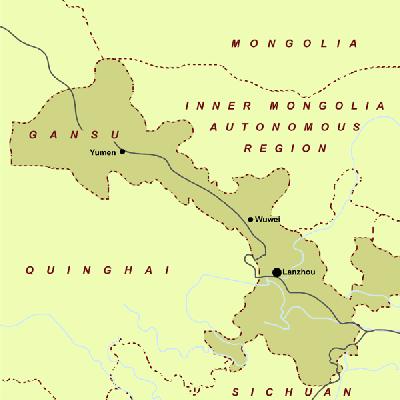About
Gansu profile
Updated: 2013-10-17( chinaculture.org )

Situated 92"10"-108"43" east longitude and 32"36"-42"47" north latitude, Gansu province in the upper Yellow River valley in northwest China was named after the first character of the names of its two ancient cities, Ganzhou (modern Zhangyi) and Suzhou (modern Jiuquan).
Long and narrow in shape, it has an area of more than 450,000 square kilometers. It neighbors Shaanxi in the east, Sichuan in the south, Qinghai and Xinjiang in the west, Ningxia and Inner Mongolia in the north, with a diversified topography, where the Loess Plateau, the Qinghai-Tibet Plateau and the Inner Mongolian Plateau meet. Most of its middle and east parts are of special loess topography, the Hexi Corridor in northwestern Gansu is of green land and the Gobi Desert intermittently spread. The Hexi Corridor occupies the fortress of the ancient Silk Road.
Climate
Gansu has a temperate monsoonal climate with the marked transitional characteristics of a continental climate. It has a mean annual temperature of 9 C -- the hottest month, July, averaging 20-24 C and the coldest month, January, -12-2 C -- and a mean annual precipitation of 50-500 mm, decreasing from east to west.
Administrative division and population
The province has 14 cities, with a population of 25.53 million by 2012, mainly including ethnic groups of Han, Hui, Tibetan, Dongxiang, Mongolian, Tu, Yugur and Baoan.
Food
The best dishes of Gansu Cuisine include Lanzhou Lamian (Lanzhou Beef Noodles), Roasted Chicken in Jingning, Dunhuang Saozi Noodles, and West Long Preserved Ham, etc.
Culture
Hua'er (flower), Long Opera, Qinqiang, Shadow Play, Lanzhou Drum, etc
Brief Introduction
Gansu province is also called Long or Gan for short. It is the cradle of Chinese culture. According to archeological findings, the Yangshao Culture emerged in this area about 6,000 years ago. During the reign of Emperor Wu of the Western Han Dynasty (206BC-AD8), the Silk Road linking the Central Plains with the Western Regions was built.
This ancient trade route starts in the old capitals of Luoyang and Xi'an, reaches the Yellow River at Lanzhou, follows along the Hexi Corridor and stretches along the edge of deserts and mountains. Before the discovery of the sea route to India, the Silk Road was the most important connection between the Orient and the West, via which China's ancient four inventions, pottery, iron wares were exported to the West, and astronomy, mathematics, religions and gems were introduced into China. Gansu was officially established during the Yuan Dynasty (1271-1368).
So far as the industries are concerned, there are equipment manufacture for petroleum, chemical industry, non-ferrous metals and petrochemical industry, all of which have occupied the important position in the whole country. The agricultural products mainly include wheat, cotton, flax and sugar beet, among which flax occupies an important position in the country.
The traditional specialties of fame are carved jade wine cup, carpets modeled after ancient ones, three-red apples, angelica, almond, benne, Bailan melon and lily, etc. Some of the rare animals found in Gansu include giant panda, golden monkey, red deer, snow rooster and wild donkey.
Rich cultural relics are the most important tourist resources in Gansu province. The famous Silk Road is the link in ancient time between China and western countries. Oases, ancient towns, passes, part of the Great Wall, temples and grottos attract thousands of visitors home and abroad every year. Places of historic and cultural interest include the Dunhang Grottos and the Jiayu Pass (an important outpost in ancient China and at the western end of the Great Wall), etc.
Gansu is renowned as home of grotto art. The Dunhuang Mogao Grottos, also known as the "Thousand Buddha Grottoes", is located at the rock side of the Singing Sand Mountain in Dunhuang city of Gansu province. It is the largest and best-preserved Buddhist art museum and also a post along the ancient Silk Road. According to historical records, the Mogao Grottos were carved in 366. There are 492 grottos in existence with some 45,000 square meters of murals, and 415 painted clay figures. It's worthy of the name of Art Treasure House of China.


